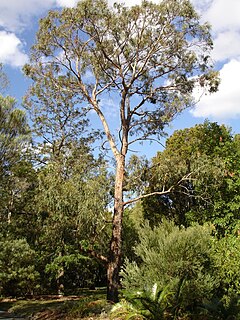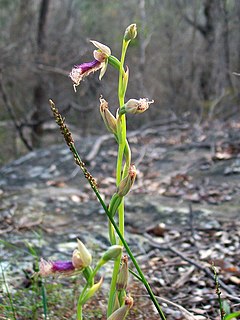
Calochilus robertsonii, commonly known as the purple beard orchid or purplish beard orchid, is a species of orchid native to Australia and New Zealand. It has a single dark green leaf and up to nine green to brown flowers with reddish or purplish stripes. The labellum has a glossy purple, mauve, or bronze-coloured beard with a ridge between the "eye" spots.

Calochilus paludosus, commonly known as the red beard orchid or red beardie, is a species of orchid native to Australia and New Zealand. It has a single fleshy, light green leaf and up to nine greenish flowers with reddish stripes. The labellum has a dull red or coppery coloured beard and lacks the "eye" spots of other beard orchids.
Genoplesium oliganthum, commonly known as the Mongarlowe midge orchid and as Corunastylis oligantha in Australia, is a small terrestrial orchid which is endemic to New South Wales. It has a single thin leaf and up to nine greenish brown to reddish flowers with a purplish labellum. It grows with grasses and shrubs on the Southern Tablelands.
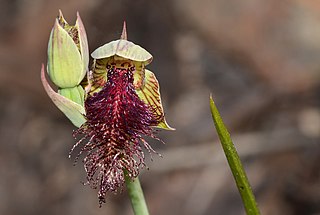
Calochilus stramenicola, commonly known as the wandoo beard orchid, is a species of orchid endemic to Western Australia. It has a single smooth, erect leaf and up to seven dull greenish flowers with reddish brown or purplish stripes. The labellum has a purplish beard with a ridge between two "eye" spots.
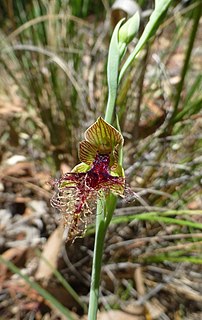
Calochilus therophilus, commonly known as the late beard orchid, is a species of orchid endemic to eastern Australia. It has a single channelled, dark green leaf with a reddish base and up to fifteen dull greenish flowers with bold red stripes. The labellum has a dark purplish beard with two "eye" spots. Unlike that of other beard orchids, there is no prominent ridge between the eye spots.
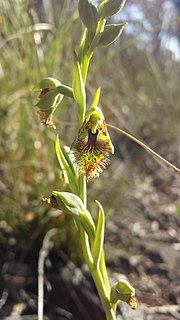
Calochilus therophilus, commonly known as the mountain beard orchid, is a species of orchid endemic to New South Wales and the Australian Capital Territory. It has a single fleshy, channelled, dark green leaf and up to fifteen green flowers with reddish lines. The labellum has two shiny metallic blue to purple plates near its base and there is no ridge between the two "eyes" on the column.

Calochilus caeruleus, commonly known as the wiry beard orchid, is a species of orchid native to northern Australia and New Guinea. It has a single leaf which continues to develop during flowering and up to twelve greenish flowers with reddish brown markings and a labellum with a red "beard".

Calochilus herbaceus, commonly known as the pale beard orchid, is a species of orchid native to south-eastern Australia and northern New Zealand. It has a single very short, rigid, fleshy leaf and up to eight pale green to brownish flowers with reddish stripes and a purple "beard".
Calochilus ammobius, commonly known as the sand beard orchid, is a species of orchid endemic to Queensland. It has a single leaf which is not present during flowering and up to three dull green flowers with reddish brown streaks and a labellum with a purple "beard".
Calochilus caesius, commonly known as the blue beard orchid, is a species of orchid endemic to the Northern Territory. It has a single leaf which is not present during flowering and up to five pale green, very short-lived flowers with a bluish-red "beard".
Calochilus gracillimus, commonly known as the slender beard orchid or late beard orchid, is a species of orchid endemic to eastern Australia. It has a single dark green leaf with a reddish base and up to nine green flowers with red stripes and a reddish, brownish or purplish "beard".
Calochilus grandiflorus, commonly known as the giant beard orchid or golden beard orchid, is a species of orchid endemic to eastern Australia. It has a single leaf with a reddish base and up to fifteen relatively large golden bronze-coloured flowers with a red or coppery red "beard".
Calochilus holtzei, commonly known as the ghostly beard orchid, is a species of orchid endemic to northwestern Australia. It has a single leaf and up to twenty pale green to yellowish flowers with red markings and a labellum with a greenish "beard".
Calochilus imperiosus, commonly known as the imperial beard orchid, is a species of orchid endemic to northern Australia. It has a single leaf and up to fifteen dull green flowers with red or purple markings and a labellum with a pinkish red "beard".
Calochilus metallicus, commonly known as the metallic beard orchid, is a species of orchid endemic to Tropical Queensland. It has a single dark green leaf and up to four pale green flowers with a pinkish or reddish "beard" on the labellum.
Calochilus praealtus, commonly known as the lofty beard orchid, is a species of orchid endemic to the Northern Tablelands of New South Wales. It has a single pale green leaf and up to six pale green flowers with faint red stripes and a labellum with a dark purple beard. It is only known from two mountainous areas.
Calochilus pulchellus, commonly known as the pretty beard orchid, is a species of orchid endemic to the south coast of New South Wales. It has a single dark green leaf with a dark red base and up to five pale green to greenish yellow flowers with red striations and a labellum with a coppery red "beard". Fewer than thirty plants growing in three sites are known.
Calochilus richae, commonly known as the bald-tip beard orchid, is a species of orchid endemic to a small area in Victoria. It is a rare species, discovered in 1928 but not seen again until 1968 and its numbers are in decline. It has a single dark green leaf and up to five reddish brown flowers with darker stripes and a labellum with short, spiky, purplish "hairs".
Calochilus sandrae, commonly known as the brownish beard orchid, is a species of orchid endemic to the higher parts of southern New South Wales. It has a single greenish brown leaf with a reddish base and up to five brownish green flowers with red striations and a labellum with a brownish purple "beard".
Calochilus uliginosus, commonly known as the swamp beard orchid, is a species of orchid endemic to Western Australia. It has a single dark green leaf with a reddish purple base and up to seven greenish to brownish flowers with red lines and a labellum with a reddish purple beard.










